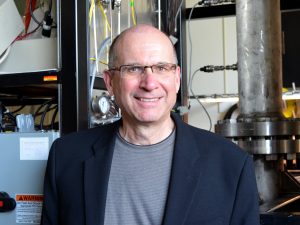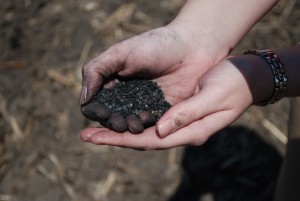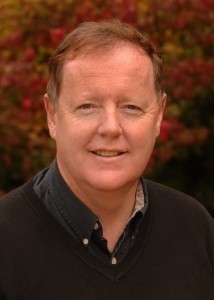Imagine a shift from our current petroleum economy—where carbon is pumped out of the ground to generate energy—toward an economy in which energy and other products are generated while putting carbon back into the ground, ultimately reducing the amount of carbon dioxide (CO2) in the air.

Iowa State’s Robert C. Brown and a group of researchers from across the nation are hoping to gather momentum behind an idea that would do just that, building a carbon negative economy.
Brown is the leader of the Initiative for a Carbon Negative Economy, as well as an Anson Marston Distinguished Professor in Engineering, Gary and Donna Hoover Chair in Mechanical Engineering, Iowa Farm Bureau director of the Bioeconomy Institute, director of the Center for Sustainable Environmental Technologies, and professor of mechanical engineering, chemical and biological engineering, and agricultural and biosystems engineering.
He says ICNE, which is supported by the College of Engineering’s Dean’s Research Initiatives, will take a combination of ideas and approaches to make it viable, including dedicated leadership, the right economic approach and a profound understanding of the technology involved.
That’s why a team of ISU faculty has organized a National Panel for a Carbon Negative Economy to engage experts from academia, industry and the national labs to explore the possibilities of this idea.
“With ICNE, we’ve defined a technology that has potential global and multinational impact,” Brown says, “but the trick is defining the appropriate scale for a project to demonstrate the concept of carbon negative energy.”
Setting the groundwork
To begin exploring the underlying ideas of ICNE, the group received “in pursuit funding” in March 2011 from the College of Engineering. The funding provided $500,000 over a three-year period to develop proposals and compete for multi-million dollar grants.
At the time, Brown said it was really about framing a carbon negative economy into compelling concepts that others could get behind, emphasizing that the economic viability is essential in generating support for ICNE.
“It started out as something of an epiphany for me because it’s so different from our model of pumping carbon out of the ground and turning it into CO2 to get net energy and net economic growth activity,” he adds. “If we can actually draw down that CO2 and generate economic activity, then we would have an economic process that generates income and reduces the effect of CO2 emissions.”
Just how will economic activity come about? That’s one of the biggest factors ICNE members are working to demonstrate, and they say biochar might just hold the answers.
An impressive byproduct

Biochar—something Brown describes as fine charcoal that is not only a stable form of carbon but is also beneficial to soils—has been on Brown’s radar for years.
The carbon-rich byproduct results from biomass pyrolysis, a technique that heats up feedstock, such as corn stover, and converts it to ingredients like bio-oil that can be used to create biorenewable materials like chemicals and fuel.
“In the past, we weren’t necessarily focused on the notion of becoming carbon negative. We were looking at how we could advance biofuels and biomaterials,” Brown explains. “Now, we recognize that we also have a product that can improve soil, and it can also sequester carbon. Biochar is a central component of a carbon negative economy.”

David Laird, agronomy professor at Iowa State, is an expert in biochar. He understands the potential of the material.
“While the notion of a carbon negative economy is not dependent on biochar—there are a number of ways you could sequester this fixed carbon—the material offers a number of advantages that can’t be overlooked,” Laird explains.
Char is a natural component of soils, especially in Iowa, where prairie fires convert biomass into char that is integrated in soil. The char is thought to be one of the reasons Iowa soil is so fertile.
“It also holds water and nutrients and reduces the soil’s density, improving aeration and allowing roots to easily penetrate through soil,” Laird says. “Beyond that, it degrades very slowly over time, so carbon is sequestered in char years longer than if the biomass were left in its natural state.”
It’s the sequestration that supports the idea of a carbon negative economy. Putting the carbon back into the soil removes the carbon from the atmosphere, and once it’s there, it starts a cycle that has several profitable advantages.
From engineering to economics

Demonstrating the economic impact of biochar is another integral part of ICNE. Dermot Hayes, Iowa State’s Pioneer Hi-Bred International Chair in Agribusiness, has done analyses showing that even fairly modest gains in yields from the use of biochar can translate into large economic impacts and increased production over time.
Hayes says the group has to examine specific issues, such as indirect land use, as well as the demand and need to increase global food production, to get backing for a carbon negative economy. Because biochar can enhance agricultural productivity, it offers a solution to these two concerns while supporting biorenewable energy.
“When you think like an economist or the U.S. EPA, you can see how this idea will work,” Hayes says. “Rather than looking at how we can get where we want to be in one year, we take into account the additional yields that will come from the char, and give them the credit over 30 years.”
Laird adds that the biochar can reverse some of the damage that has been done to existing soil, which would make food production more efficient, with less fertilizer and less energy used to grow a large amount of crops.
Critical work to be done
While each member of the group is extremely optimistic about the potential of a carbon negative economy, they recognize technical aspects of the idea still need to be refined.
Laird says the group needs to learn more about the diversity of the make up of chars. “We are looking to build a biochar industry that is optimized and efficient, but we are also dealing with a material that may be appropriate for some areas and not in others. We don’t want to cause damage somewhere because the biochar was misused.”
On top of that, the group has to consider the diversity of soil types. “Finding the right management system to improve soil quality becomes a unique thing. Char is part of a complex agricultural management system that could enhance soil quality; nutrient, water, and energy use efficiency; and food production,” Laird explains.
Hayes says the idea is economically sound, but executing the idea must be done in a way that is profitable for everybody.
Even with the need to address those issues, the researchers are confident.
“Engineering problems can be solved,” Laird says. “We need to find the best solutions, and with a little time, this idea could become a reality.”
Gathering a network of supporters
Because it requires such a drastic change in thought, members of ICNE have spent much of the past few years building awareness.
In March 2012, Brown and others presented at a two-day workshop during the Carbon War Room’s Creating Climate Wealth Summit in Washington, D.C. Representatives were also at the 2012 International Annual Meetings of the American Society of Agronomy, Crop Science Society of America, & Soil Science Society of America.
The group is launching a multi-stage project with Harry Stine, president and founder of the Stine Seed Company located in Adel, Iowa. The end goal of the project is to validate the concept of carbon negative energy at a scale large enough to attract private and public investments, allowing the group to further develop the idea.
Researchers will use Stine’s fast pyrolyzer to produce bio-oil and biochar from feedstock harvested from his farmland. Before they can do that, the pyrolyzer needs improvements in biochar collection as well as separation of the heavy and light bio-oil fractions. The group also wants to improve facilities for safe handling and storage of the co-products.
The Iowa Energy Center funded the first stage of this project, which made possible an overall assessment of the retrofits to be made to Stine’s pyrolyzer.
From there, the group is preparing detailed designs of the various pieces of equipment required to bring the pyrolyzer up to desired specifications for production of bio-oil and biochar for evaluation. The bio-oil will be used at ISU’s power plant to partially replace coal, and the char will be evaluated through soil field tests. This work will be funded with $500,000 from “Leading the Bioeconomy,” a special appropriation passed by the Iowa Legislature for ISU, as well as with contributions from Stine.
Based on what they learn, the ICNE will seek industry and U.S. Department of Energy support to bring the technology to commercial practice. The research team realizes that the biggest hurdle they face is changing perceptions about biochar.
“We have to move people past the idea that limiting greenhouse gas emissions would have a negative impact on the economy,” Laird says. “Biochar represents an opportunity where we can remove carbon from the atmosphere and increase economic activity at the same time.”
Laird is leading a new project to see how soil, biochar, climate and crops interact using APSIM, an internationally recognized, highly advanced simulator of agricultural systems. Researchers will develop and validate a biochar module to look at land and soil databases within APSIM to determine where biochar will most help increase the productivity of the land.
The project is supported by a nearly $2 million grant from the Global Climate and Energy Project based at Stanford University in California. He says the results from the module could be used in building a foundation for the biochar industry and help scale-up implementation of carbon negative energy systems.
Hayes adds that Iowa is the perfect place to show the possibilities of a carbon negative economy because of the abundant stover in the state.
“To think you can drive a car and improve the environment is a wild idea, but it can happen. Of all the systems I have looked at, this one makes the most economic sense.”